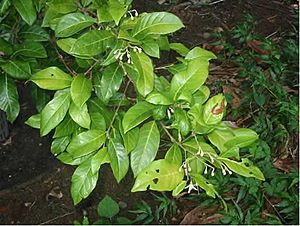Styrax portoricensis facts for kids
Quick facts for kids Styrax portoricensis |
|
|---|---|
 |
|
| Conservation status | |
| Scientific classification | |
| Genus: |
Styrax
|
| Species: |
portoricensis
|
The Palo de Jazmín (scientific name: Styrax portoricensis) is a special kind of flowering plant. It belongs to the Styracaceae family. This tree is found only in Puerto Rico, which means it is endemic there. It is one of the rarest trees in Puerto Rico. You can only find it in the Luquillo Mountains and the Cayey Mountains.
Contents
What Does Palo de Jazmín Look Like?
The Palo de Jazmín is an evergreen tree. This means it keeps its leaves all year round. It can grow very tall, up to 65 feet (about 20 meters) high.
Leaves, Flowers, and Fruit
You can spot this tree by its unique features:
- Its twigs, the underside of its leaves, and its flowers have tiny, star-shaped hairs.
- The leaves are shaped like an oval. They are about 2 ¾ to 4 ¾ inches (7 to 12 centimeters) long. They are also about 1 ¼ to 2 inches (3 to 5 centimeters) wide.
- The tree has pretty whitish flowers. Each flower is about ½ inch (1.2 centimeters) long. They hang down on short, curved stems.
- The fruit is gray-green and pointed. It has cup-shaped outer leaves called calyces. These leaves help protect the fruit.
The Palo de Jazmín usually blooms with flowers in September and October. Its fruits appear in April.
Where Does Palo de Jazmín Live?
This rare tree lives in the mountains of Puerto Rico. You can find it in the Luquillo Mountains and the Cayey Mountains. It grows in places like El Yunque National Forest and Carite State Forest. It is very hard to find because there are so few of them left.
Why Is Palo de Jazmín Endangered?
The Palo de Jazmín is a critically endangered species. This means it is at a very high risk of disappearing forever. It is protected by a special law called the Endangered Species Act. This law helps protect plants and animals that are in danger. Scientists and conservationists are working to protect these trees. They want to make sure the Palo de Jazmín can survive for many years to come.
See also
 In Spanish: Styrax portoricensis para niños
In Spanish: Styrax portoricensis para niños


